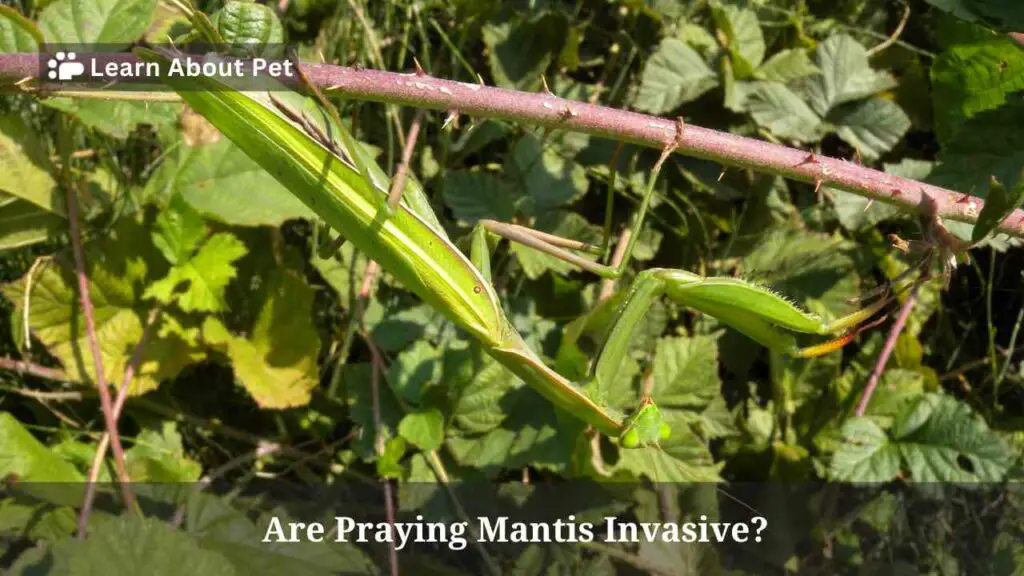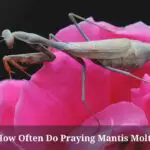In recent times, there has been debate on the question of whether or not praying mantis are invasive. This article sheds light on that subject.
Are praying mantis invasive? In some places, certain praying mantis species are non-native, over-populated and harmful to the local environments. As such, they qualify to be termed as invasive. But we also have native, non-invasive species of praying mantis.
What Is An Invasive Species?
For a species to be termed as invasive, it needs to meet 3 criteria.
Firstly, it needs to be non-native to the area.
Secondly, it needs to have become over-populated.
And thirdly, it needs to be harmful to the environment within the area under consideration.

Are Praying Mantis Invasive?
There are some species of praying mantis that qualify to be termed as ‘invasive’ in certain locations. But we also have native – and hence non-invasive – species of praying mantis.
As we have already noted, an invasive species is one that is non-native in a given area, overly populated and harmful to the local environment.
Consequently, in figuring out whether or not praying mantis are invasive, we need to apply a three way test. We need to ask ourselves, are the praying mantis native; are they over-populated and are praying mantis harmful to the environment?
That is how we end up discovering that certain praying mantis species are invasive, whereas others are non-invasive.
For instance, in North America, there is a species of praying mantis known as Stagmomantis carolina which is native and hence non-invasive.
Then we find the likes of Chinese praying mantis (Tenodera sinensis) and the European praying mantis (Mantis religiosa) which are invasive.
We often find tough invasive praying mantis vs native praying mantis competition for resources.
And since the invasive species of praying mantis have certain advantages, they typically end up upstaging the local mantis species, potentially driving them to extinction.
Are Praying Mantis Invasive In The US?
We have to start by taking note of the fact that there are at least 20 different species of mantis found in the US.
With that fact in mind, we can proceed to answer the question at hand: are praying mantis invasive in USA?
And the answer is this: some praying mantis species are indeed invasive in the USA. But there are also some species of praying mantis that are native to the USA, and hence non-invasive.
An example of a native, non-invasive praying mantis species in the USA is Stagmomantis carolina. On the other hand, an example of an invasive praying mantis species in the USA is Tenodera sinensis (the Chinese mantis) or Mantis religiosa (the European mantis).
Are Praying Mantis Good To Have Around?
Having established that some praying mantis are native/non-invasive whereas others are indeed invasive, the next pertinent question is on whether the mantises are good to have around.
Here, one may be more specific and ask, Is it OK to pick up a praying mantis as a pet? Or are praying mantis a problem in all cases? Are praying mantis dangerous or are they harmless and worth keeping?
The true position is that the native, non-invasive species of praying mantis are good to have around. They can help in biological pest control. And they also make good pets.
However, the invasive species of praying mantis are not good to have around. They are harmful to the environment, and often a threat to the native species of praying mantis.
Final verdict
Some praying mantis species are invasive, whereas others are native and non-invasive.
The invasive praying mantis species are those that have been introduced into a certain area – as opposed to being a native species there. In addition to being non-native, such praying mantis species turn out to be overpopulated and harmful to the environment.
The upshot is that one needs to be careful while selecting the species of praying mantis to keep as pets or for use in pest control. It is important to avoid the praying mantis species that are known to be invasive.

Welcome to Learn About Pet. My name is Rajkumar Ravichandran and I love all pets, travel, and amazing food. I write about my passion and personal experience caring for multiple pets in this blog! ❤️
Post Disclaimer
DISCLAIMER: THIS BLOG OR WEBSITE, "Learn About Pet", DOES NOT PROVIDE YOU WITH MEDICAL ADVICE AND IS NOT A SUBSTITUTE FOR MEDICAL ADVICE. ALWAYS GET IN TOUCH WITH YOUR PERSONAL VETERINARIAN AND USE INFORMATION HERE AS GENERAL ADVICE.
The information, including but not limited to, text, graphics, images and other material contained on this website are for informational purposes only. No material on this site is intended to be a substitute for professional veterinary advice, food recommendation, diagnosis, or treatment. Always seek the advice of your veterinarian or other qualified health care provider with any questions you may have regarding a medical condition or for pet food related questions.







